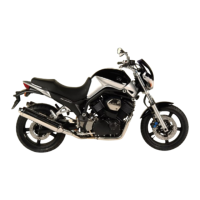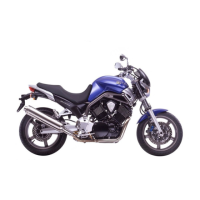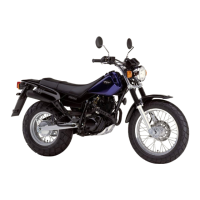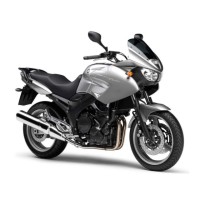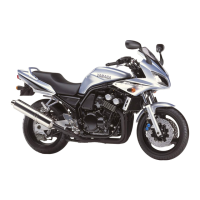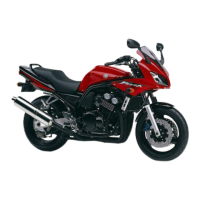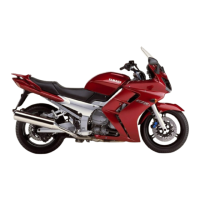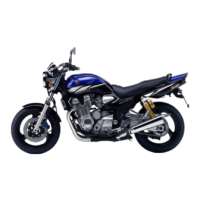Do you have a question about the Yamaha BT1100 2002 and is the answer not in the manual?
Explains how critical information is highlighted using symbols like WARNING and CAUTION.
Details how to find the Vehicle Identification Number and Model Label for vehicle recognition.
Outlines essential precautions for maintenance, including preparation, parts, gaskets, seals, and circlips.
Provides steps for inspecting electrical connectors for cleanliness, moisture, and proper connection.
Lists and illustrates specialized tools required for specific maintenance and repair tasks.
Lists general dimensions, weight, engine type, displacement, bore, stroke, and other basic vehicle data.
Details specific measurements and tolerances for engine, chassis, and electrical systems during maintenance.
Provides standard torque values for common fasteners and general tightening principles.
Identifies lubrication points and recommends specific lubricants for engine and chassis components.
Provides a schedule for routine checks and lubrication based on odometer readings and annual intervals.
Covers periodic inspections and adjustments related to the motorcycle's engine components.
Details periodic inspections and adjustments for the motorcycle's chassis and related systems.
Outlines periodic checks and adjustments for the motorcycle's electrical system components.
Steps for removing the engine, including associated components like fuel tank and exhaust system.
Procedures for removing, checking, and installing the front and rear cylinder heads.
Procedures for removing, checking, and installing the clutch assembly and its components.
Procedures for disassembling, checking, and installing the crankshaft and connecting rods.
Details the process of checking, disassembling, assembling, and installing the carburetors.
Covers the function, components, and inspection of the Air Induction System.
Instructions for replacing brake pads, servicing master cylinders, and calipers for both front and rear brakes.
Procedures for removing, disassembling, checking, assembling, and installing the front fork legs.
Instructions for handling, removing, checking, and installing the rear shock absorber and swingarm.
Troubleshooting and maintenance procedures for the shaft drive system, including oil checks and backlash adjustment.
Covers the ignition system's circuit diagram and troubleshooting procedures.
Explains the starting system's circuit diagram, operation, and troubleshooting.
Details the charging system's circuit diagram and troubleshooting steps.
Provides circuit diagrams and troubleshooting for headlights, indicators, and other lights.
Lists potential causes and troubleshooting steps for starting issues, categorized by fuel, electrical, and compression systems.
Details common causes and solutions for hard shifting, stuck shift pedals, and gears jumping out.
Lists possible causes for engine overheating, spanning ignition, fuel, compression, and oil systems.
Provides troubleshooting for lighting failures (headlight, tail, license plate, meter) and signaling system issues (flashers, horn).
Explains how critical information is highlighted using symbols like WARNING and CAUTION.
Details how to find the Vehicle Identification Number and Model Label for vehicle recognition.
Outlines essential precautions for maintenance, including preparation, parts, gaskets, seals, and circlips.
Provides steps for inspecting electrical connectors for cleanliness, moisture, and proper connection.
Lists and illustrates specialized tools required for specific maintenance and repair tasks.
Lists general dimensions, weight, engine type, displacement, bore, stroke, and other basic vehicle data.
Details specific measurements and tolerances for engine, chassis, and electrical systems during maintenance.
Provides standard torque values for common fasteners and general tightening principles.
Identifies lubrication points and recommends specific lubricants for engine and chassis components.
Provides a schedule for routine checks and lubrication based on odometer readings and annual intervals.
Covers periodic inspections and adjustments related to the motorcycle's engine components.
Details periodic inspections and adjustments for the motorcycle's chassis and related systems.
Outlines periodic checks and adjustments for the motorcycle's electrical system components.
Steps for removing the engine, including associated components like fuel tank and exhaust system.
Procedures for removing, checking, and installing the front and rear cylinder heads.
Procedures for removing, checking, and installing the clutch assembly and its components.
Procedures for disassembling, checking, and installing the crankshaft and connecting rods.
Details the process of checking, disassembling, assembling, and installing the carburetors.
Covers the function, components, and inspection of the Air Induction System.
Instructions for replacing brake pads, servicing master cylinders, and calipers for both front and rear brakes.
Procedures for removing, disassembling, checking, assembling, and installing the front fork legs.
Instructions for handling, removing, checking, and installing the rear shock absorber and swingarm.
Troubleshooting and maintenance procedures for the shaft drive system, including oil checks and backlash adjustment.
Covers the ignition system's circuit diagram and troubleshooting procedures.
Explains the starting system's circuit diagram, operation, and troubleshooting.
Details the charging system's circuit diagram and troubleshooting steps.
Provides circuit diagrams and troubleshooting for headlights, indicators, and other lights.
Lists potential causes and troubleshooting steps for starting issues, categorized by fuel, electrical, and compression systems.
Details common causes and solutions for hard shifting, stuck shift pedals, and gears jumping out.
Lists possible causes for engine overheating, spanning ignition, fuel, compression, and oil systems.
Provides troubleshooting for lighting failures (headlight, tail, license plate, meter) and signaling system issues (flashers, horn).
| Displacement | 1063 cc |
|---|---|
| Compression ratio | 8.3:1 |
| Transmission | 5-speed |
| Final drive | Shaft |
| Front suspension | Telescopic fork |
| Rear suspension | Swingarm |
| Front brakes | Dual disc |
| Rear brakes | Single disc |
| Front tire | 120/70-ZR17 |
| Rear tire | 170/60-ZR17 |
| Fuel capacity | 20 liters |
| Engine type | Air-cooled, 4-stroke |
| Length | 2215mm |
| Height | 1175mm |
| Fuel system | Carburetor |
